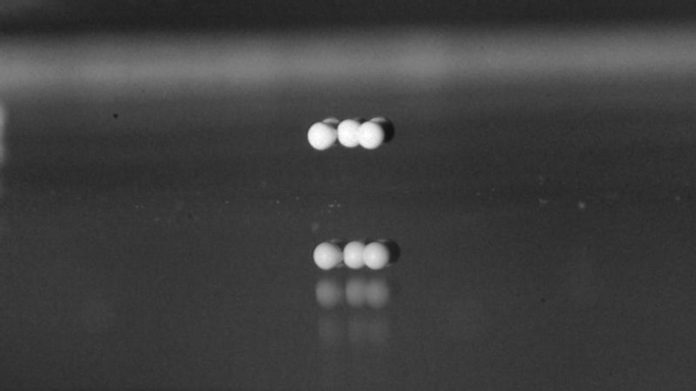Mechanically agitated granular matter often serves as a prototype for exploring the rich physics associated with hard-sphere systems, with an effective temperature introduced by vibrating or shaking. While depletion interactions drive clustering and assembly in colloids, there are no equivalent short-range attractions exist between macroscopic grains.
In a new study by the University of Chicago and the University of Bath addressed this limitation and investigated granular cluster formation by using acoustic levitation and trapping. They used sound waves to levitate particles, revealing new insights about how materials cluster together in the absence of gravity.
Heinrich Jaeger, the Sewell Avery Distinguished Service Professor of Physics said, “Much of the universe is made up of particles assembling. With acoustic levitation, we have a beautiful model system to study assembly at scales visible to the human eye, where we can track each particle with precision, and then relate the results to a wide range of often much more microscopic phenomena.”
During the study, scientists were interested in the shape of prototypical clusters that structure when, starting from a single particle, more are included one by one. They utilized sound waves to levitate plastic particles in midair – each around one millimeter in diameter, about the thickness of a penny – and contemplated how these particles collaborate with one another as they framed groups, separated, and afterward reassembled into various arrangements.
At the point when there are five particles or less, they found, the particles thickly in just a single setup. Be that as it may, when there are at least six particles, there are various diverse shapes they could collect into when together firmly.
By using high-speed cameras to track the levitated particles, the researchers were able to capture these various configurations. They found that groups of six particles can form three distinct compact shapes: parallelogram, chevron, and triangle. Adding one more particle to make seven meant that particles clustered together in one of four shapes, which scientists termed a flower, a turtle, a tree or a boat.
Co-first author Anton Souslov, then a UChicago postdoctoral researcher and now on the faculty at the University of Bath said, “Six particles is the minimum needed to change between different shapes, which is where things get interesting. For us scientists, defying gravity to levitate dust also has this more fundamental interest of developing Earth-based experiments to understand how bodies in space like planets start to form.”
Scientists noted, “This would be the very earliest stages when the future planet is just a clump of space dust perhaps a centimeter across — before gravity starts to become a factor.”
“One unique aspect of the experiments is that the sound not only levitates the particles but can also be used to affect how they interact as they float.”
Graduate student Melody Lim, the first author on the paper said, “A surprise was that by changing the sound wave frequency, we could manipulate the clusters and influence the shape that emerged. Modeling the physics behind such acoustic forces, which was done by Souslov and professor of physics Vincenzo Vitelli, gives scientists a new means to control the assembly process.”
They found that rearranging the shapes often depends on one particle acting as a “hinge” and swinging around the others to reconfigure, which could be very useful in a range of potential applications.
The research team now intends to look at how acoustic levitation can bring together larger numbers of particles to assemble more complex structures.
The study is published in the journal Nature Physics.
